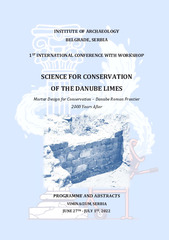Приказ основних података о документу
The role of brick in the Late Antique architecture of the Central Balkan Roman provinces [predavanje po pozivu]
| dc.contributor | Korać, Miomir | |
| dc.contributor | Nikolić, Emiija | |
| dc.contributor | Jovičić, Mladen | |
| dc.creator | Radivojević, Ana | |
| dc.date.accessioned | 2023-11-13T18:45:30Z | |
| dc.date.available | 2023-11-13T18:45:30Z | |
| dc.date.issued | 2022 | |
| dc.identifier.isbn | 978-86-6439-072-9 | |
| dc.identifier.uri | https://raf.arh.bg.ac.rs/handle/123456789/1454 | |
| dc.description.abstract | Complex research of late antique bricks from the area of today's Serbia, conducted at the beginning of the 21st century, included the analysis of this material from several archaeological sites, including the ancient Viminacium. The idea was to determine the similarities and deviations of bricks and brick construction techniques in the observed areas concerning the overall late antique architecture of ancient Rome. Therefore, extensive analyses of the literature and the results of previous research were conducted, in conjunction with fieldwork and laboratory testing of appropriate samples from the field. The research indicated that construction techniques that were used in the area of today's Serbia in the time of late antiquity were completely in line with the way of building in the area of the Eastern Roman Empire. As a rule, they included the use of bricks, and most often it was the opus mixtum technique, performed in a manner of late antiquity, while in the case of smaller buildings, the opus testaceum technique could also be used. The analyzed area had a specific role in the turbulent period of the invasion of barbarian tribes in the Eastern Roman Empire resulting that by the end of the 4th century the area was mostly devastated and depopulated. However, during the 6th century and the reign of Emperor Justinian, the area of northern Illyricum revived and gained strategic importance to preserve the northern borders of the Empire, so that some cities were revived, while completely new fortified settlements were built. The new circumstances have contributed to the intensification of construction activities with noticeably more extensive use of brick and more frequent application of the opus testaceum technique on significantly larger buildings than was the case in the previous period of construction activity during the 4th century. At the same time, there is a certain change in the formats of bricks, which from the elongated rectangular formats that were typical of late antiquity in the observed areas, become closer in shape to the square. Visual observation of 6th-century bricks gives the impression of their poorer quality compared to 4th-century bricks. Morphological, as well as physicochemical analyzes conducted on bricks of the 4th and 6th centuries from selected sites, give an initial picture of the quality of used bricks. The gained knowledge of the quality of the analyzed bricks in combination with their format and applied building technique becomes a good basis for a better understanding of the behavior of late antique buildings, but the real picture of this can be obtained in combination with similar research focussed on mortars that were applied. | sr |
| dc.language.iso | en | sr |
| dc.publisher | Belgrade : Institute of Archaeology | sr |
| dc.rights | openAccess | sr |
| dc.source | Mortar design for conservation – Danube Roman frontier 2000 years after [Elektronski izvor] : programme and abstracts / 1st International Conference with Workshop Science for Conservation of the Danube Limes, Viminacium, June 27th - July 1st, 2022 | sr |
| dc.subject | brick | sr |
| dc.subject | brickwork | sr |
| dc.subject | morphological properties | sr |
| dc.subject | physicochemical properties | sr |
| dc.title | The role of brick in the Late Antique architecture of the Central Balkan Roman provinces [predavanje po pozivu] | sr |
| dc.type | conferenceObject | sr |
| dc.rights.license | ARR | sr |
| dcterms.abstract | Радивојевић, Aна; | |
| dc.rights.holder | Institue of Archaeology | sr |
| dc.citation.spage | 121 | |
| dc.citation.epage | 123 | |
| dc.identifier.fulltext | http://raf.arh.bg.ac.rs/bitstream/id/5031/bitstream_5031.pdf | |
| dc.identifier.rcub | https://hdl.handle.net/21.15107/rcub_raf_1454 | |
| dc.type.version | publishedVersion | sr |

